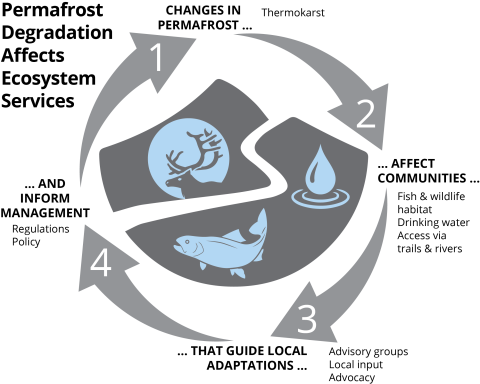
The Issue
Degrading permafrost is making life in Arctic communities more challenging because 7ishing and hunting, access to drinking water, and travel via trails and rivers (i.e., ecosystem services) are becoming less reliable or predictable.
Why It Matters
Many people in the Arctic depend on 7ish and wildlife for food. Animal habitat is expected to change, in part as a result of permafrost degradation, meaning that traditional harvesting locations may not remain the same. Permafrost degradation can also disrupt sources of drinking water. Permafrost degradation also diverts trails and disrupts river travel, altering access to recreational and harvest opportunities. Permafrost plays a key role in Arctic ecosystem services, and informed decisions are necessary because management and adaptation solutions can be costly.
State of Knowledge

Permafrost degradation changes how water is distributed across the landscape. The presence of permafrost prevents in7iltration to the subsurface, which results in extensive lakes and wetlands in 7lat areas where precipitation alone would be insuf7icient to sustain their existence. Permafrost degradation in ice-rich ground leads to thermokarst terrain, a patchwork of localized features that form when ground ice rapidly thaws and the surrounding ground surface subsides into the area previously occupied by ice. This uneven ground collapse modi7ies surface water patterns within soils, wetlands, lakes, and stream drainage networks. In turn, these changes in hydrology, with some places becoming wetter and some drier, alter the vegetation, soil, and ecosystem dynamics that together provide food and habitat for wildlife.
Permafrost acts as a provisioning service for 7ish and wildlife, because surface water is a key resource, as well as a structural feature for both terrestrial and aquatic ecosystems. Thermokarst formation, with accompanying erosion, has been identi7ied as an important driver of habitat change for 7ish and wildlife. Permafrost thaw and bank erosion delivers sediment into streams and rivers and directly affects 7ish habitat. Changes in stream drainage networks and 7low rates can increase or decrease invertebrate productivity (a food resource for 7ish); alter water temperature, water chemistry; and increase the stranding of 7ish. Shorebirds, for example the American golden plover, the semipalmated sandpiper, and the red-necked phalarope, as well as waterfowl such as the greater white-fronted goose, are increasingly using new habitats created as a result of degrading permafrost. Animals such as moose and caribou are also likely to be affected by the relationship between changing permafrost, 7ire, and wetland distribution where habitat quality and food availability can be substantially altered as a result of permafrost thaw. Some ecosystems may support more moose and caribou and some may support less. In general, habitats, and the animals they support, are unlikely to remain the same as permafrost degrades.
Permafrost also plays an important role in regulating water availability for human use. Water supply depends on whether permafrost is continuous (found everywhere), where surface water is the main source, or discontinuous (found only in some locations), and where groundwater is more readily accessible. Drinking water derived from surface water in continuous permafrost environments can be vulnerable to rapid change. For example, the village of Point Lay in northwestern Alaska lost its fresh water source suddenly in August of 2016 when ground ice separating the reservoir from the adjacent river thawed and the reservoir subsequently drained. In other continuous permafrost locations, increases in algal blooms and other microorganisms have been observed to decrease water quality when permafrost degrades. In discontinuous permafrost environments, degradation can increase connectivity between surface and ground water, with the potential to decrease water quality. In general, regions with discontinuous permafrost appear to be more vulnerable than regions of continuous permafrost or permafrost-free regions. Across all permafrost regions, the challenge of obtaining adequate water is often ampli7ied by the dif7iculty of maintaining utilities in frozen ground environments.
Permafrost stabilization of the ground surface is also a key ecosystem service in terms of access and transportation. Trails play a major role in the Arctic and boreal region, making access possible for both recreation and for cultural practices, including harvest. All-terrain vehicles or other forms of surface transportation disturb the insulating moss and organic soil layer, leading to permafrost degradation. Trails meander through thermokarst terrain to 7ind the easiest path forward, compounding these effects. Rivers also provide access in areas with permafrost that often lack of road connectivity. River navigation is becoming more dif7icult because of rapid channel changes in part linked to permafrost degradation, bank erosion, and the input of new sediment. Local knowledge from Alaska attests to these factors directly affecting when and where people access traditional ecosystem use areas.
Where the Science is Headed
Continued efforts are needed to quantify speci7ic associations between permafrost degradation and the availability of ecosystem services. Active work includes spatially- explicit models of thermokarst vulnerability, which can link ecosystem-based information with comprehensive landscape modeling. Models of this type can be used to forecast the complex effects of permafrost degradation. It is also important to catalog local human adaptations to permafrost degradation in order to prioritize research for management and adaptation. Evaluating interactions among permafrost degradation, erosion, river channel changes, river ice stability, and plant community succession is important for informed management decisions. Trail hardening and stabilization efforts are often too costly for the majority of affected areas, and novel approaches will be needed to develop and maintain access to recreational and harvest opportunities.
Key References
- Martin, P.D., J.L. Jenkins, F.J. Adams, M.T. Jorgenson, A.C. Matz, D.C. Payer, P.E. Reynolds, A.C. Tidwell, and J.R. Zelenak. 2009. Wildlife Response to Environmental Arctic Change: Predicting Future Habitats of Arctic Alaska. Workshop Report 17-18 November 2008. Fairbanks, Alaska: U.S. Fish and Wildlife Service. 138 pp.
- Schuur, E.A.G., and M.C. Mack. 2018. Ecological response to permafrost thaw and consequences for local and global ecosystem services. Annual Reviews of Ecology, Evolution, and Systematics.
Contacts
Erin Trochim, University of Alaska
edtrochim [at] alaska.edu
Ted Schuur, Northern Arizona University
ted.schuur [at] nau.edu
SEARCH Science Brief AA-017. Supported by the National Science Foundation.
| Attachment | Size |
|---|---|
| aa017-permafrost-degredation.pdf374.62 KB | 374.62 KB |
